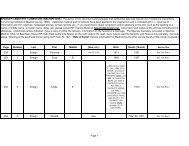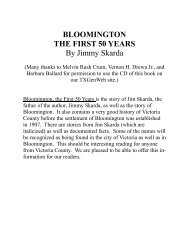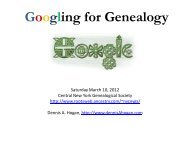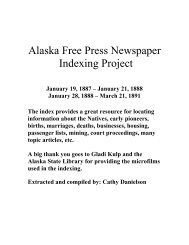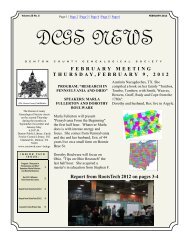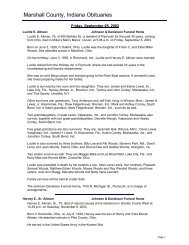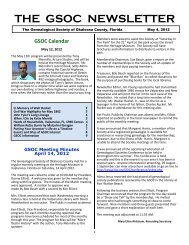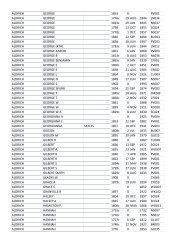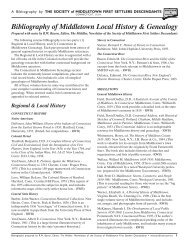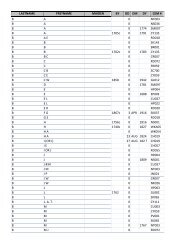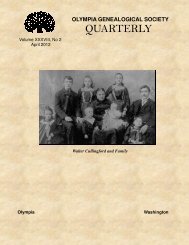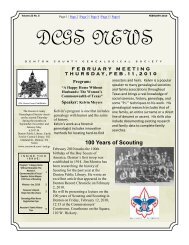Indian population in the United States and Alaska. 1910 - RootsWeb
Indian population in the United States and Alaska. 1910 - RootsWeb
Indian population in the United States and Alaska. 1910 - RootsWeb
Create successful ePaper yourself
Turn your PDF publications into a flip-book with our unique Google optimized e-Paper software.
For <strong>the</strong> male <strong>Indian</strong> <strong>population</strong> 10 years of age <strong>and</strong><br />
over <strong>the</strong> "proportion ga<strong>in</strong>fidly occupied <strong>in</strong>creased from<br />
59.2 per cent <strong>in</strong> 1900 to 61.3 per cent <strong>in</strong> <strong>1910</strong>, while for<br />
<strong>the</strong> female <strong>Indian</strong> <strong>population</strong> 10 years of age <strong>and</strong><br />
over <strong>the</strong> proportion ga<strong>in</strong>fully occupied <strong>in</strong>creased from<br />
13.8 per cent <strong>in</strong> 1900 to 16 per cent <strong>in</strong> <strong>1910</strong>.<br />
In <strong>Alaska</strong> <strong>the</strong> proportion of <strong>the</strong> total <strong>Indian</strong> <strong>population</strong><br />
engaged <strong>in</strong> ga<strong>in</strong>ful occupations decreased from<br />
43.1 per cent <strong>in</strong> 1900 to 32.1 per cent <strong>in</strong> <strong>1910</strong>, while<br />
<strong>the</strong> proportion of <strong>the</strong> <strong>population</strong> 10 years of age <strong>and</strong><br />
over engaged <strong>in</strong> ga<strong>in</strong>ful occupations decreased from<br />
55.2 per cent <strong>in</strong> 1900 to 45 per cent <strong>in</strong> <strong>1910</strong>. This<br />
great decl<strong>in</strong>e was conf<strong>in</strong>ed ma<strong>in</strong>ly to females, <strong>the</strong> pro-<br />
portion ga<strong>in</strong>fully employed be<strong>in</strong>g 22.1 per cent <strong>in</strong><br />
1900, as compared with 6.1 per cent <strong>in</strong> <strong>1910</strong>, for <strong>the</strong><br />
total female <strong>Indian</strong> <strong>population</strong>, <strong>and</strong> 28.2 per cent <strong>in</strong><br />
1900, as compared with 8.7 per cent <strong>in</strong> <strong>1910</strong>, for <strong>the</strong><br />
female <strong>Indian</strong> <strong>population</strong> 10 years of age <strong>and</strong> over'.<br />
This decl<strong>in</strong>e, moreover, was conf<strong>in</strong>ed pr<strong>in</strong>cipally to a<br />
few occupations. The number of female <strong>Indian</strong>s<br />
returned as fishermen, or fish curers <strong>and</strong>, packers,<br />
decreased from 1,349 <strong>in</strong> 1900 to 298 <strong>in</strong> <strong>1910</strong>; <strong>the</strong> number<br />
returned as hunters, trappers, or guides decreased<br />
from 1,271 <strong>in</strong> 1900 to 46 <strong>in</strong> <strong>1910</strong>; <strong>and</strong> <strong>the</strong> nimiber<br />
returned as basket makers decreased from 274 <strong>in</strong> 1900<br />
to 93 <strong>in</strong> <strong>1910</strong>. These decreases, amoimt<strong>in</strong>g to 2,457,<br />
more than equal <strong>the</strong> decrease from 1900 to <strong>1910</strong> <strong>in</strong> <strong>the</strong><br />
number of female <strong>Indian</strong>s ga<strong>in</strong>fully employed <strong>in</strong><br />
<strong>Alaska</strong>. It is impossible to determ<strong>in</strong>e from <strong>the</strong> figures<br />
to what extent <strong>the</strong>se great decreases were real <strong>and</strong> to<br />
what extent <strong>the</strong>y were apparent only <strong>and</strong> due to<br />
<strong>in</strong>accuracies <strong>in</strong> enumeration at <strong>the</strong> two censuses; but<br />
a comparison with <strong>the</strong> statistics show<strong>in</strong>g <strong>the</strong> proportion<br />
of <strong>the</strong> female <strong>Indian</strong>s of <strong>the</strong> <strong>United</strong> <strong>States</strong> proper<br />
engaged <strong>in</strong> ga<strong>in</strong>ful occupations <strong>in</strong> 1900 <strong>and</strong> <strong>in</strong> <strong>1910</strong>,<br />
OCCUPATIONS. 251<br />
respectively (Table 101), <strong>in</strong>dicates that <strong>the</strong> proportion<br />
reported for <strong>the</strong> female <strong>Indian</strong>s of <strong>Alaska</strong> probably<br />
was too large for 1900 <strong>and</strong> too smaU for <strong>1910</strong>.<br />
Table 102 shows, for each of 22 selected states, <strong>the</strong><br />
number <strong>and</strong> proportion of males <strong>and</strong> females 10 years<br />
of age <strong>and</strong> over engaged <strong>in</strong> ga<strong>in</strong>ful occupations <strong>in</strong><br />
<strong>1910</strong>, while similar statistics are presented for each<br />
pr<strong>in</strong>cipal stock <strong>and</strong> tribe <strong>in</strong> <strong>the</strong> <strong>United</strong> <strong>States</strong> <strong>and</strong><br />
<strong>Alaska</strong> <strong>in</strong> Table 103 (p. 253). The proportion of each<br />
sex engaged <strong>in</strong> ga<strong>in</strong>ful occupations <strong>in</strong> each pr<strong>in</strong>cipal<br />
tribe is also shown graphically <strong>in</strong> <strong>the</strong> diagram on<br />
page 252.<br />
Table 102



